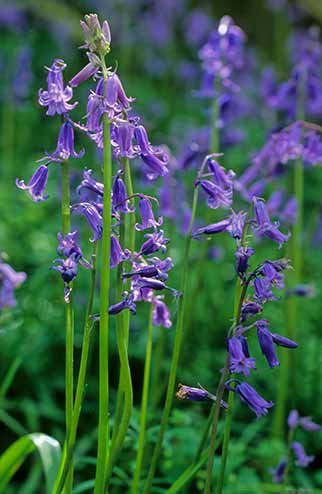Bluebells (Endymion non-scriptus)
When: April-May
How many: Fairly widespread, but not often abundant

A visit to a bluebell wood is one of the great joys of spring. Carpeting the ground beneath a canopy of fresh green leaves, massed ranks of bluebells form a sight to match almost any in the natural world.
Long, slender bluebell leaves break through the soil from January onwards, but it is not until April that the buds open to reveal the much awaited, pendulous blooms. Then for a number of weeks, once-grey winter woodland becomes transformed into a sea of shimmering blue.
Edward Step in the early 1900s wrote of bluebells as ‘a cloud or mist of blue resting on the earth’, but Alfred, Lord Tennyson perhaps best captured the magic in the 19th century, referring to bluebells as ‘like the blue sky, breaking up through the earth’, for this is exactly as it seems.
Closely related to cultivated hyacinths, extensive patches of bluebells offer an almost uniquely British experience, for bluebells flourish here in the damp, relatively mild climate, but do not occur much beyond Europe’s western fringes.
In fact, British bluebells are internationally important, so-much-so that under relatively recently introduced legislation, anyone uprooting bluebells without the permission of the landowner risks a heavy fine.
But bluebells are not particularly common in the New Forest, for they prosper only in drier, well-fenced inclosures. Elsewhere, in places open to the depredations of commoners’ stock, and deer, bluebells tend to occur only in small numbers, and then as weak, straggling specimens.
It is not grazing, though, that is the major problem for bluebells, but trampling of the leaves that really causes the damage, reducing the plant’s ability to obtain the foodstuffs needed to sustain the underground bulb through the long autumn and winter period.
Colin Tubbs in The New Forest – A Natural History provides an example of the effect on bluebells of stock and deer. In Broomy Inclosure, near Linwood, the boundary fence was relocated in the late 1960s, leaving open half of a previously protected, extensive carpet of bluebells. Within two years, bluebell density had significantly reduced, whilst individual plants had become smaller and more prostrate.
Bluebells grow well, however, in the well-fenced inclosure at Pondhead, near Lyndhurst, whilst here, rotational hazel coppicing, thinning of the broadleaved trees, conifer removal and deliberate creation of clearings has produced further, quite extensive bluebell-friendly habitat.
References:
The New Forest – A Natural History: Colin R. Tubbs
Reader’s Digest Field Guide to the Wild Flowers of Britain
Wild Flowers Month by Month in their natural haunts: Edward Step
The Works of Alfred, Lord Tennyson
More links
Other related links
Search this site

Sadly, 58 animals were killed - 35 ponies, 13 cows, 8 donkeys and 2 sheep, whilst a further 32 were injured - 3 pigs, 9 donkeys, 11 cows and 9 ponies.
(Forty-three accidents occurred in daylight, 15 at twilight and 101 in the dark. Twenty-seven accidents were not reported by the driver involved).
Here's just one horrific example - Three donkeys killed in collision with van at notorious New Forest blackspot (Advertiser and Times)

